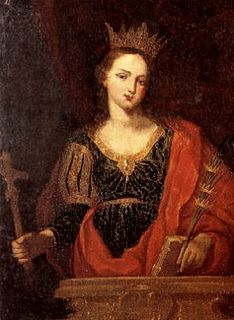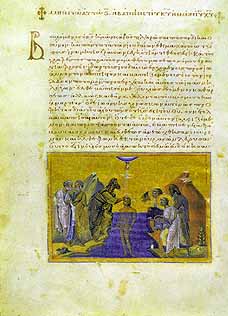The 380s decade ran from January 1, 380, to December 31, 389.

Flavia Maxima Fausta (289–326) was a Roman Empress, daughter of the Roman Emperor Maximianus. To seal the alliance between them for control of the Tetrarchy, in 307 Maximianus married her to Constantine I, who set aside his wife Minervina in her favour. Constantine and Fausta had been betrothed since 293.

Saint Agathaof Sicily is a Christian saint. Her memorial is on 5 February. Agatha was born at Catania or Palermo, Sicily, and she was martyred in approximately 251. She is one of seven women, who, along with the Blessed Virgin Mary, are commemorated by name in the Canon of the Mass.

According to some Eastern Christian traditions, Thaddeus,, was one of the seventy disciples of Christ, possibly identical with Thaddeus of the Twelve Apostles.

Saint Anastasia is a Christian saint and martyr who died at Sirmium in the Roman province of Pannonia Secunda. In the Orthodox Church, she is venerated as St. Anastasia the Pharmakolytria, i.e. "Deliverer from Potions".

Saint Catherine of Alexandria is an oil painting by the Italian Baroque master Caravaggio. It is part of the Thyssen-Bornemisza Collection of Madrid.

Saint Blandina was a Christian martyr who died at Lyon, France during the reign of Emperor Marcus Aurelius.

February 5 - Eastern Orthodox liturgical calendar - February 7

For the Roman Empress, see Fausta. For the Catholic saint, see Saint Fausta.

Felicitas of Rome, also anglicized as Felicity, is a saint numbered among the Christian martyrs. Apart from her name, the only thing known for certain about this martyr is that she was buried in the Cemetery of Maximus, on the Via Salaria on a 23 November. However, a legend presents her as the mother of the seven martyrs whose feast is celebrated on 10 July. The Eastern Orthodox Church celebrates their martyrdom on 25 January.
Saint Maximus of Aveia is one of the patron saints of L'Aquila, Italy.
Tryphaena was a Roman Christian woman that lived in the Roman Empire. She was the daughter of Roman nobles Anastasius and Socratia. Her parents named her in honor of Antonia Tryphaena, who was a prominent citizen in Cyzicus and was a Pontian Princess, who was a former Roman client Queen of Thrace. From whom Tryphaena was named after, in Cyzicus she always connected to Antonia Tryphaena. Cyzicus is an ancient Greek city, which is located in modern Turkey.

The woman with seven sons was a Jewish martyr described in 2 Maccabees 7 and other sources. Although unnamed in 2 Maccabees, she is known variously as Hannah, Miriam, and Solomonia.

Saint Paraskevi of Rome or Parasceva of Rome is venerated as a Christian martyr of the 2nd century. She is invoked for the healing ailments of the eyes. Her feast day is July 26.

Saint Aurea of Ostia is venerated as the patron saint of Ostia. According to one scholar, “[a]lthough the acta of Saint Aurea are pious fiction, she was a genuine martyr with a very early cultus at Ostia.”

Saint Venera is venerated as a Christian martyr of the 2nd century. Little is known of this saint. The date of her death is traditionally given as July 26, 143 AD.

The Menologion of Basil II is an illuminated manuscript designed as a church calendar or Eastern Orthodox Church service book (menologion) that was compiled c. 1000 AD, for the Byzantine Emperor Basil II. It contains a synaxarion, a short collection of saints' lives, compiled at Constantinople for liturgical use, and around 430 miniature paintings by eight different artists. It was unusual for a menologion from that era to be so richly painted. It currently resides in the Vatican Library . A full facsimile was produced in 1907.
Theodula of Anazarbus was an early Christian saint and martyr who lived in the city of Anazarbus during the reign of the Roman emperors Diocletian (284-305) and Maximian (305-311).















